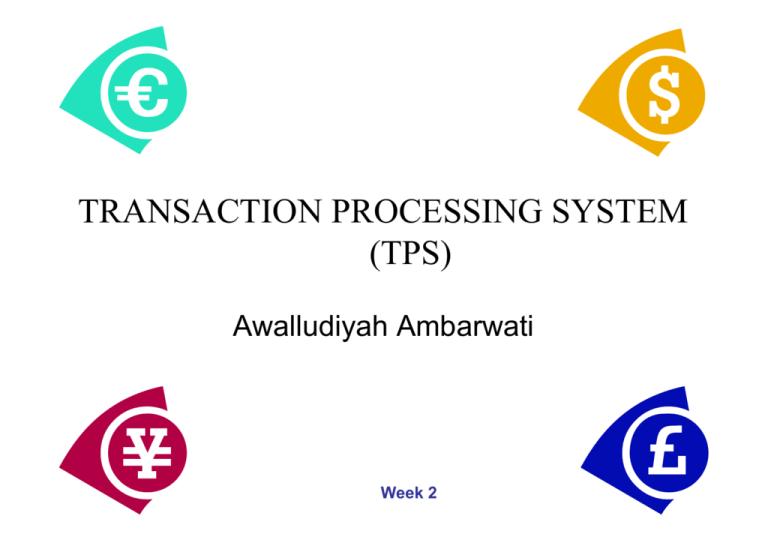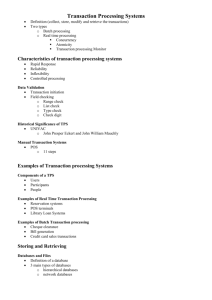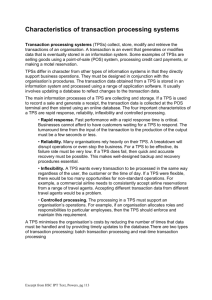TRANSACTION PROCESSING SYSTEM (TPS)
advertisement

TRANSACTION PROCESSING SYSTEM (TPS) Awalludiyah Ambarwati Week 2 Financial Information System Model Characteristics of Functional Information Systems 1. A functional information system consists of several smaller information systems that support specific activities performed in the functional area. 2. The specific IS applications in any functional area can be integrated to form a coherent departmental functional system, or they can be completely independent. 3. Functional information systems interface with each other to form the organization-wide information system. 4. Some organizational information systems interface with the environment. 5. Information systems applications support the three levels of an organization’s activities: operational, managerial, and strategic. The Four Major Types of Information Systems Transaction Processing • Transaction – An exchange involving goods or services Transaction Processing Systems (TPS) • Computerized system that performs and records the daily routine transactions necessary to conduct the business; these systems serve the operational level of the organization • Information system used to support and record transactions Transaction Processing Systems (TPS) • Basic business systems that serve the operational level • A computerized system that performs and records the daily routine transactions necessary to the conduct of the business Transaction Processing Systems (TPS) • Aplikasi sistem informasi yang menangkap dan menangani data transaksi Transaction Processing Systems Transaction Processing Systems (TPS) = “the information system that support business processes, mainly accounting & finance transactions, with some sales, personnel, & production activities as well.” TPS is the backbone of an organization’s information systems. It monitors, collects, stores, processes & disseminates information for all routine core business transactions. These data are input data to functional information systems applications, DSS, and CRM. Transaction Processing Systems (TPS) Meliputi data maintenance, yaitu menyediakan, mengupdate serta menyimpan data dan Business process redesign (BPR), yaitu mempelajari, menganalisa dan merancang ulang proses transaksi dasar untuk mengurangi biaya dan atau meningkatkan nilai tambah. TPS, MIS/DSS, and Special Information Systems Transaction Processing System • TYPE • • • • • : Operational-level INPUTS : transactions, events PROCESSING: updating OUTPUTS : detailed reports USERS : operations personnel, supervisors DECISION-MAKING: highly structured The Transaction Processing Cycle 1. 2. 3. 4. 5. Data collection Data editing Data correction Data manipulation Data storage The Transaction Processing Cycle • Data collection – The process of capturing transaction related data • Data editing – Checking the validity of data entered • Data correction – Implemented if an error is found in the entered data • Data manipulation – Processing transaction data • Data storage – Altering databases to reflect the transaction The Transaction Processing Cycle Different Transaction Processing for Different Needs • Order processing system – Supports the sales of goods or services to customers – Arranges for shipment of products • Purchasing system – Supports the purchase of goods and raw materials from suppliers TPS Interaction Objectives of TPS • Primary goal of TPS • Specific objectives of a TPS Objectives of TPS Primary goal of TPS To provide all the information needed by law and/or by organizational policies to keep the business running properly and efficiently. Objectives of TPS Specific objectives of a TPS to allow for efficient & effective operation of the organization. to provide timely documents and reports. to increase the competitive advantage of the corporation. to provide the necessary data for tactical & strategic systems, such as Web-based applications. to ensure accuracy & integrity of data & information. to safeguard assets & security of information. The purpose of TPS 1. To Keep records about the state of the organization 2. To process transactions that affect the records 3. To produce output that reports on transactions that have occurred Transaction Processing System Structure Transaction Processing System Structure 1. Inputs to a transaction processing system come from users and other transaction processing systems. 2. Outputs go to users and other transaction processing systems. 3. Transaction processing system files and databases store data about the state of the organization. 4. Transaction processing system software accepts data about transactions, processes it, makes changes in stored data, and produces the outputs Activities of TPS First, data are collected & entered into the computer via any input device. The system then processes data in one of the following ways: Batch processing= the firm collects data from transactions as they occur, placing them in groups or batches. The system then processes the batches periodically Online processing = data are processed as soon as a transaction occurs. Hybrid system (a combination of batch & online processing) collects data as they occur but process them at specified intervals. 26 Traditional Transaction Processing Methods & Objectives • • • • Batch processing systems On-line transaction processing (OLTP) On-line entry with delayed processing Process data generated by and about transactions • Process data generated for and about transactions • Maintain a high degree of accuracy and integrity • Produce timely documents & reports Batch processing systems • All transactions for a period of time would be collected in a group (called a batch), input & processed as a unit. • Data for all transactions to be processed is brought together and processed in a group (Payroll). • This was normally done at regular intervals, such as every hour, day, or week. Batch processing systems • The biggest problem with batch processing is that the master file is never current. • Good for some applications, such as processing end of semester grades or payroll, it is unacceptable for others, such as financial transactions. • Problems that would arise if your bank only processed deposits and withdrawals once a day! • However, batch processing is fast and cost effective for many applications. Batch Transaction Processing On-line transaction processing (OLTP) • Online transaction processing is interactive & each transaction is processed as it occurs. • Files are always current when online processing is used. • The drawback to OLTP is the high costs associated with the necessary security & fault tolerance features. • A person enters the data for a transaction into a system, where it is processed and the output is received before the next input is entered (airlines) On-line entry with delayed processing • When online entry with delayed processing is used, data is input as the transaction occurs and is stored online, but files are not updated. • Files are updated later in batch. • For example, orders taken over the phone may be entered into the system, but not processed until a slow time, such as at night. On-Line Transaction Processing Traditional Transaction Processing Methods & Objectives • • • • Increase labor efficiency Help provide improved service Help build and maintain customer loyalty Achieve competitive advantage Transaction Processing System Functions Input function Processing function: Output function: • Capture input data • Enter input data • Validate input data • perform computation • make decision • produce screen output • print output Storage function: • stored data • Access data • Update data • Transaction processing systems perform input, output, storage, and processing functions. • Input functions include capturing data on a source document, entering the input data into the system, and checking input data for errors, a process called data validation • Output functions include producing screen or paper reports, such as detail reports, summary reports, and exception reports. • Storage functions include storing data in files and databases ,accessing stored data, sorting stored data, and updating stored data. • Processing functions involve the manipulation of data, including computation and decision making Transaction Processing Systems Integration of a Firm’s TPSs Order Processing Systems • • • • • • • • Order entry Sales configuration Shipment planning Shipment execution Invoicing Customer relationship management (CRM) Routing and scheduling Scheduling systems Order Entry System Input function • Accept customer order data Processing function: Output function: • check inventory quantity • Check customer credit Storage function: •Storage customer order data •Access inventory master data •Access customer order data • produce sales order • The purpose of an order entry system is to accept customer orders for goods and services and to prepare the orders in a form that can be used by the business. • If sufficient inventory is on hand and the customer’s credit rating is acceptable, a sales order, which is the output from the system, is produced by the program. • This document contains the customer number, name, and shipping address from the customer master data; the item and the description from the inventory master data; and the quantity ordered from the customer order data. Example of TPS • An inventory control system keeps a file of records about the stock of goods that a business has on hand (the inventory) which is one aspect of the state of the business. • When items are shipped or received, the state of the business is affected, and the inventory control system makes changes about the inventory in the stored records. • Periodically, the system prints a list of the shipments and receipts - that is the transactions that have occurred. • It also prints a report giving the quantity on hand for each item in inventory, which is a characteristic of the state of the business. • Finally, when inventory is low, the system produces output that causes more inventory to be ordered, which is another type of business transaction. Examples of TPS Examples of TPS Benefits of Internet Transaction Processes Flexibility to accommodate unpredictable growth in processing demand. Cost effectiveness for small dollar amounts. Interactive, automatic billing, enabling companies to offer services to anyone, not just subscribers. Timely search and analysis of large databases. Ability to handle multimedia data such as pictures and sound effectively and efficiently. High data throughput to support inquiries requiring massive file size. Fast response time. Effective storage of huge graphics and video databases. • Copy of this material or other material about this lecture (task, exam, etc), please visit http://ambar-mylove.blogspot.com/








